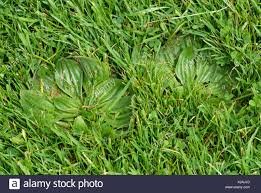Miracle Plant that grows wild in your lawn

The medicinal herb known as plantain is a low-growing plants that you can find growing almost anywhere. Some people believe plantain is a weed, but it’s actually one of the best medicinal and free herbs anywhere in the world.
Plantains have been used medicinally and as food plants around the world. Indigenous North Americans used it to heal wounds, cure fever, and to draw out toxins from stings and bites, including snakebites.
You have likely seen the two main types of plantains; the ones with broad leaves that are completely green with no purple are called Plantago major and the narrow-leaved type is called Plantago lanceolata. Both have healing purposes, depending on the availability in your locality, but most herbalists seem to prefer the broadleaf plantain with larger, but softer, edible leaves. However, when dealing with a summer cold a tea made from the long Lanceolata leaves will be the most beneficial.
Plantains have antimicrobial properties in addition to being a strong anti-inflammatory medicine and an analgesic. It can not only soothe insect bites and superficial wounds but prevent infections and incredibly speed up healing. Plaintain contains Aucubin which is responsible for the antimicrobial action of the medicinal plant, whereas Allantoin in the herb helps with the regeneration of skin tissue. This amazing plant also has astringent properties. It helps dry up excess secretions in the respiratory tract and the digestive system, thus being useful in treating colds and diarrhea. Most often the Lanceolata strain is used for this purpose. The mucilage of the hen makes is a much more gentle astringent than many others.
This amazing plant when used as a food source has edible leaves that are rich in calcium and other minerals and vitamins, including Vitamin K. Tender leaves can be eaten fresh in salads, but older leaves have to be cooked. The entire plant can be eaten. Young leaves can be eaten raw or cooked. They are somewhat bitter and tedious to prepare because it’s generally preferable (though not required) to remove the fibrous strands before use. Many people blanch the leaves in boiling water before using them in salads in order to make them more tender. Once blanched, plantain can be frozen then used later in a sauté, soup or stew. The seed can be ground into a meal and mixed with flour. Dried leaves make a healthy herbal tea.
Uses for Plantain
Plantain is used to treat a variety of everyday problems, such as bug bites and stings, skin rashes, kidney problems and gastrointestinal issues.
Burns – Apply a poultice immediately and apply a bandage with leaves. You can make a poultice just by chewing up the leaves. For continued after care it is best to follow-up with a plantain salve.
Cuts and open sores – wash with plantain tea and follow-up with a plantain salve or tincture.
For poison ivy/sumac/oak – Apply a poultice immediately, and then wash the area with plantain tea. Follow up with plantain salve or tincture until the stinging pain is gone.
For sunburn – Apply fresh poultic and then apply the salve.
To improve liver and kidney function or help with Gastrointertinal inflammation– Drink 1-2 glasses of plantain tea every day.
For cold, flu, and respiratory infections – Drink freshly brewed warm tea made from the Lanceolata leaves - adding elderberry syrup can also help speed healing
Collecting Plantain
Although this plant has many uses, it is considered a weed and many believe it to be an invasive species. If you find them growing in abundance in wastelands in your area, it’s better to gather them from there, rather than introduce them into your garden.
Plantain leaves are mainly used for herbal preparations, so it is best to pick just the leaves, that way you can return to gather another day. Pinch off leaves, selecting slightly mature ones over the very tender leaves, unless you’re planning to use them in salads. Mature leaves have a higher concentration of phytochemicals and are therefore more medicinal.
The easiest way to make a poultice and use plantain while out in nature is to collect the leaves and crush them in your hands then chew the crushed leaves and then place them on the effected area. The Poultice will draw to toxins from a sting or bite so apply liberally.
Plantain Tincture
Plantain leaves washed and dried of excess moisture – 1 cup
100 proof vodka or brandy – 1 pint
Glass jar with tight-fitting lid
Put the leaves into a jar and pour ever clear alcohol over it so that it completely covers the leaves and fills the jar. stir well.
Put the lid on and place the jar in a dark place, agitate every few days.
After 8 weeks, pour it clean bottles and store in a dark place and discard the leaves
Plantian Salve an easy DIY
Ingredients
⅓ c dried plantain
½ c olive
⅓ oz beeswax
1ml/20 drops of tea tree oil
Instructions
Infuse your carrier oil with the dried plantain - just put them in a clean jar together and let it sit for two weeks
Strain the oil out into a clean jar.
Melt your beeswax using a double boiler. Watch it carefully!
Add your infused oil to the beeswax as soon as the beeswax is melted. The cooler oil may cause parts of the beeswax to become solid again, but just stir it gently as it heats up until it's all mixed together well. Remove it from heat as soon as it's completely liquid and combined.
You can add 20 drops of tea tree oil to add more antibacterial properties and to help preserve the salve. Stir it in!
Pour the liquid into a tin or jar for storage. It will harden as it cools... and it's ready!
https://steemit.com/christianity/@bible.com/verse-of-the-day-revelation-21-8-niv